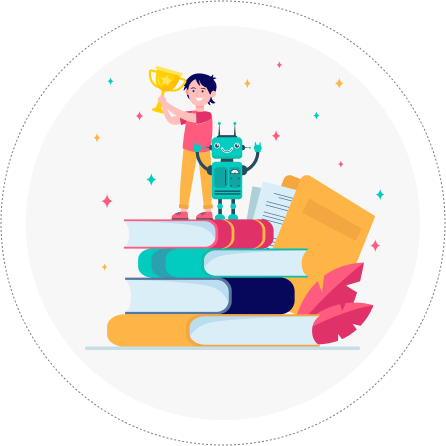Information Technology Class 11
- Home
- / Python Handay
- / Information Technology Class 11
Welcome!
Information Technology for CBSE Class 11th students is a 100-Mark subject encompassing Java Programming, Database Management System (MySQL), Computer Organization , Computer Networking, Office, and Employability Skills . The examination structure comprises a 60-Mark theory paper and a 40-Mark practical paper administered at schools under the supervision of an examiner.
Prerequisites
Before delving into Information Technology -11th, it’s essential to have a basic understanding of operating systems.
Learning Objectives
Students will acquire fundamental expertise in java programming languages, database management, Computer Organization , Computer Networking, Office , laying a solid foundation for advanced studies in the IT sector or pursuing degrees such as BCA, B.Sc(IT) thereby significantly enhancing career prospects in the field.
Course Overview
Introduction to Object-Oriented Programming
Java Fundamentals
Understanding Primitive Data Types
Need and Usage of Variables
Usage of Operators: Assignment, Arithmetic, Relational, Logical, Bitwise
Selection Statements: if, if-else, switch-case
Properties and Methods of GUI Components: jButton, jLabel, jTextField, jTextarea, jRadiobutton, jCheckbox, jPasswordField, jListBox, jComboBox
Attaching Code to Components (e.g., jButton, jLabel, jTextField) and Creating Simple JFrame Applications
Using Various GUI Components: jTextarea, jRadiobutton, jCheckbox, jPasswordField, jListBox, jComboBox, JTable, JOptionPane, JPanel
Extensive Live Programming Practice (Minimum 60 Programs
Database and Its Purpose
Components of a Table
Relational Database Model Terminology (Relation, Tuple, Attribute, Cardinality)
Keys: Primary, Candidate, Alternate, Foreign
Introduction to MySQL
Classification of MySQL Commands: DDL, DML
Data Types in MySQL: char, varchar, decimal, int, date, time
Creating a Database
Creating a Table
Viewing Table Structure
Adding Constraints to a Table
Modifying Table Structure
Viewing All Tables in a Database
Deleting Table Structure
Adding Rows to a Table
Viewing Table Content
Displaying Selected Data with Conditions
Sorting Data
Modifying Data in a Table
Deleting Data from a Table
Introduction to Fundamentals of Computers and Uses
Characteristics of Computers
Components of Computers
Block Diagram of Computers
Task Execution Process
Steps in Process Execution
Functions of Computer Components and CPU
Identifying Computer Components
Functions and Uses of I/O Devices
Introduction to Storage Devices
Memory Units of Storage
Introduction to Operating Systems
Functions of Operating Systems
Types of Operating Systems
Differences Between Operating Systems
Introduction to Common Troubleshooting
Troubleshooting Hardware Problems
Printer Troubleshooting
Understanding Printer IP and Settings
Sound Troubleshooting and Speaker Settings
Software Troubleshooting
Networking Troubleshooting
Disk Space Management
Disk Cleanup and Recycle Bin Management
Disk Defragmentation
Removing and Disabling Unused Programs
Restarting the System
Using Command Prompt for File Search
Introduction to Networking
Need and Benefits of Networking
Components of a Network: Sender, Receiver, Message, Channel
Transmission Medium: Wired and Wireless
Telephone Network Standards (Technologies in each generation)
Working Devices: RJ45 Connector, Modem, Repeater, Hub, Switch, Bridge, Gateway, Router
Network Topologies: Bus, Star, Ring, Tree, Mesh
Types of Networking: LAN, MAN, WAN, PAN, VAN
Introduction and Use of the Internet
Digital Literacy
Terminology: Channels, Bandwidth, ISP
Internet Devices: Repeater, Hub, Switch, Gateway, Bridge, Router
Data Transfer Rates: bps, Kbps, Mbps, Gbps
Protocols: TCP/IP, FTP, HTTP, SMTP, POP3, PPP, UDP
Network Safety Concerns: Digital Footprints, Threats, Malware, DoS, Eavesdropping
Networking Security Measures: Antivirus, Firewall, Login IDs, Passwords
Cyber Crime: Phishing, Hacking, Identity Theft, Cyber Bullying
Cyber Safety: Netiquettes, IT Act, Cyber Laws
Introduction to Word Processing Applications (e.g., OpenOffice)
Word Processing Window Components
Tabs and Submenu Options in OpenOffice Writer
Creating Tables in Word Processors
Introduction to Spreadsheets
Installing Open Source Spreadsheet Software (e.g., Calc)
Spreadsheet Window Components
Spreadsheet Formatting Features
Working, Saving, and Closing Spreadsheets
Working with Data in Spreadsheets
Using AutoFill and Data Formatting
Text Flow and Formatting Options
Numeric Data Formatting
Find and Replace Data
Deleting Data, Cells, Rows, and Columns
Using Formulas and Functions in Spreadsheets
Operators and Predefined Functions
Addressing/Referencing Types
Sorting and Filtering Data
Creating and Modifying Charts and Graphs
Working with Macros in Spreadsheets
Printing Spreadsheets
- Communication Skills
- Self-Management Skills
- ICT Skills
- Entrepreneurial Skills
Green Skills
- Lab Test Office Automation : 15 Marks
- Lab Test of Java 10 Marks
- Lab Test of MySQL 05 Marks
- Practical File: 05 Marks
- Viva voce : 05 Marks
Enquiry Now
Our Courses
Data Analyst using Python
Select Tech MindGuru for Why ?
Placement Assistance
Placement assistance offered for a successful career.
Membership
Membership provided until the final examination.
Personalized Attention
Personalized attention provided to each student.

Get Course Certificate
Certificate awarded upon completion of the course.
Monthly Tests
Regular monthly test series for progress evaluation.
Latest CBSE Syllabus
Training modules aligned with the latest CBSE syllabus.
Frequently Asked Questions
Students interested in IT infrastructure, software, databases, and networking. It’s great for those exploring IT support, web development, and software services.


